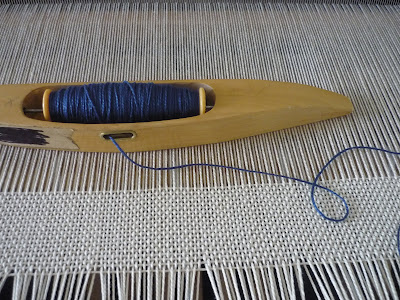
After all of the heddles have been threaded, the yarn can be tied onto the back beam in small groups. The back beam is a rod that secures the threads, but also enables them to be wound and unwound from the back. This means you can have your threads a lot longer than just the length of your loom frame.
Note how messy this looks, especially on the left side. The threads are all technically in order and going through the reed and the heddles straight, but once on the back side the order gets slightly mixed up when tying onto the back beam. This is not a problem, it is normal.

A close-up shot of how to tie the knot around the back beam. You take a group of threads, bring the group over the back beam, then split the group in half and bring the two halves up and around on either side of itself. Then just tie a square knot. This method will prevent any chance of the knot slipping when you put tension on the threads. (I tried overhand knots once--not a good idea!) It's important that your thread ends are all about the same length at this point, it will make the rest of the process at the front much easier.

Here is the whole loom just before I start winding. The ends of the threads are tied onto the back beam and pass through the heddles, then the reed, and come out the front. You can see there is quite a lot of length to wind on just lying on the floor, still in its warp chain form. When I start winding onto the loom, the thread will move onto the back and be wrapped around another rod.

Here I've started winding on. This shows the back with the threads all nice and orderly going around the second rod. You can see the handle to turn it around at the bottom of the picture. Also note the brown paper being rolled at the same time. If you don't use some sort of paper in between the threads, you'll have major problems. The paper keeps the different layers seperated. Notice that the threads look nice and not messy anymore; they're being spaced out evenly by the reed and heddles they pass through

Periodically when winding on, you have to stop and untangle the threads at the front so they can feed through easily. It was very interesting working with this set of warp chains. You remember I had three separate chains. Well, the group on the left (in this picture the one at the bottom), was perfectly straight--I hardly had to untangle it at all. The center group was pretty good, it had a normal amount of tangles, but nothing too annoying.
Then, the group on the far right (see the top of this picture, behind my hand), was so incredibly tangled and messed up that I spent way too much time fussing with it to straighten it out every few inches. The cause of this is some mistake in the warp cross when I sleyed the reed. It was all out of order and twisting around itself. So, take this as a prime example of the importance of breaking up your threads into different groups, and the importance of the warp cross. If I had one big warp chain and the whole thing was that tangled, I'd probably trash it and start over.

















































